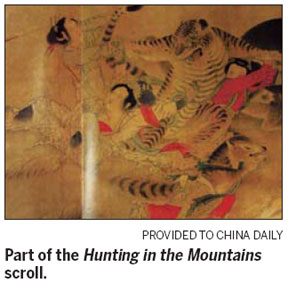Heritage
Angels and demons in Song figure painting
Updated: 2011-06-07 08:12
By Cheng Anqi (China Daily)
EDITOR's Note: Every week we look at a work of art or a cultural relic that puts the spotlight on China's heritage.
Figure painting is the earliest of genres to appear in the history of Chinese painting and continues to occupy a pre-eminent position.
Chinese figure painting first appeared in the Neolithic era - on pottery, tiles, tombs, cave walls and family shrines.

The earliest ink figure paintings, created during the Warring States Period (475-221 BC), were done on silk, as paper appeared only in the first century AD.
The portrayal of figures - usually of heavenly beings, emperors, court ladies and common people - saw its heyday in the Tang Dynasty (AD 618-907).
Through their depictions of feasts, worship and street scenes, painters captured the religious beliefs and everyday lives of ancient China.
One such example is the Hunting in the Mountains scroll, which depicts the mythical Erlang (True Lord) and his cohort.
The god is a household name in China, thanks to his duel with the Monkey King in the novel Journey to the West.
Erlang impresses viewers with his third truth-seeing eye in the middle of the forehead, which helped him hunt and once even defeat the Monkey King who possesses the magical powers to undergo 72 types of transformations.
In the unsigned piece of colored ink art, made during the Song Dynasty (960-1279), he appears as the central figure.
About 533 cm long and 53 cm wide, the silk scroll housed in the Palace Museum was based on the folk legend of Erlang who roamed the mountains to hunt and expel demons.
Done in the delicate gongbi (fine-brush) style, the vigorous brushwork shows the skill of the artist in bringing strange animals and figures to life.
In the painting, immortal troops from the heaven, led by Erlang, make a splendid show of their strength as they hunt down demons and spirits which, according to folk beliefs, inhabit the forests and mountains.

Brandishing weapons, such as swords, spears and halberds, the divinities let loose falcons and dogs in an effort to intercept evil spirits and cut short their retreat.
The malevolent spirits are embodied in the forms of tigers, bears, pigs, monkeys, foxes, lizards and snakes as well as tree-dwelling spirits.
Pursued by the army of divinities, some demons resort to their original appearances while others take on feminine forms in an attempt to flee into the caves or wriggle out of captivity.
While the gods are usually represented as upright characters, the painting shows their savage side. It is the demons who have a kinder and gentler appearance.
The miserable state of these panic-stricken creatures as portrayed by the artist evokes sympathy.
"The painting conjures up an image of the common people who fell prey to soldiers riding roughshod over them during the period when this painting was created," says Yu Hui, a researcher on painting and calligraphy at the Palace Museum in Beijing.
China Daily
E-paper

Harbin-ger of change
Old industrial center looks to innovation to move up the value chain
Preview of the coming issue
Chemical attraction
The reel Mao
Specials

Vice-President visits Italy
The visit is expected to lend new impetus to Sino-Italian relations.

Birthday a new 'starting point'
China's national English language newspaper aims for a top-notch international all-media group.

Sky is the limit
Chinese tycoon conjures up green dreams in Europe with solar panels
